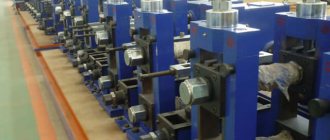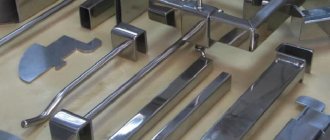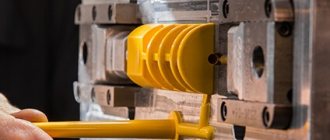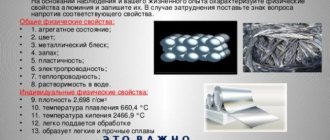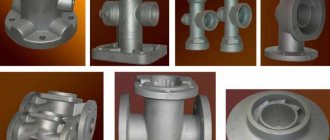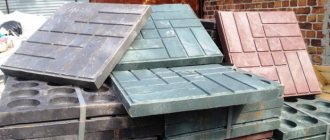Products made from polymer-sand composites have been produced in Russia for about 10 years.
Most of them are piece building materials of relatively small sizes: tiles, shingles, curb stones.
However, the strength of the material makes it possible to produce more massive structures, such as elements of decorative fences, rings for wells and septic tanks.
The technology for producing polymer sand products is also attractive due to the possibility of using recycled polymer material , which does not require deep cleaning.
Cheap raw materials, in-demand products, and tax breaks make it possible to open a highly profitable enterprise, receive commercial benefits and reduce the burden on the environment.
Components of polymer sand mixture
One of the advantages of polymer-sand mixtures is the simplicity of the composition. There is no standard recipe ; each manufacturer develops it at the factory independently, based on the availability of components.
Polymer sand
composite consists of :
- Filler . Pure sifted sand with a fraction size of up to 3 mm is considered one of the best materials. It should not contain clay and dusty inclusions, which reduce the strength properties of finished products. A negative factor affecting the quality of the mixture is considered to be increased humidity of the filler: evaporation during the preparation of the mixture and molding of finished products leads to the formation of voids. It is possible to use other mineral fillers: granite screenings, quartzite, basalt, glass, porcelain, broken ceramic bricks.
- Pigment . The technology for producing polymer sand products involves through coloring, so pigments are introduced into the mixture. It is possible to use any mineral and organic dyes. The most popular: chromium oxide, titanium dioxide, red lead, cobalt blue. The main selection criteria: availability, price and UV resistance.
- Binder . Most soft and hard thermoplastic polymers are suitable for the production of polymer-sand compositions. The most commonly used materials are high- and low-density polyethylene, polypropylene, PET, and ABS plastic. A mixture of several plastics can be used as a binder. In this case, it is necessary to ensure that they have approximately the same softening temperatures. Based on this requirement, it is necessary to avoid polycarbonates, tetrafluoroethylene (Teflon), and other refractory polymers from entering the raw material mixture. Sources of polymer binders most often are production waste (rejects, scraps, sprues) and consumption waste (MSW, used packaging). Depending on the configuration of the production line, unprepared, crushed plastics or granules can be used. Most manufacturers prefer recycled granulate because it is cheaper.
- Plasticizers . To increase the mobility of the mixture and facilitate the molding process, dibutyl phthalate, tricresyl phosphate and similar substances are introduced into the mixture.
- Reinforcement . Synthetic, organic and mineral fiber materials can be added to increase tensile and flexural strength. For reinforcement, asbestos, cotton floss, glass and acetate fiber are most often used.
Among the undesirable substances that can get into the mixture, experienced manufacturers note machine oils and aluminum foil.
The ratio of components is determined by manufacturing and testing prototypes.
The mixture contains:
- 23 – 38% polymer material;
- 60 – 75% filler;
- up to 2% pigments and other additives.
Advantages of polymer tiles
Polymer sand tiles consist of the following components:
- quartz sand (3/4 of the composition);
- high-density polyethylene (25% of the composition);
- a small part of other petroleum products.
This composition makes the material plastic and resistant to negative external influences.
The advantages of the product include
- durability – the polymer coating lasts up to 30 years;
- stability - the material is not afraid of frost, moisture, heavy loads, liquids containing acid and oil;
- Decorative – tiles are often made in any shape. Moreover, it often has a glossy, matte or structured surface. And also when making polymer tiles, craftsmen can use a wide range of colors;
- no toxic fumes when exposed to direct sunlight;
- reusable and easy to repair if damaged;
- ease of cleaning the coating (tiles are easy to clean);
- wide scope of application. Polymer sand tiles are used as a decorative covering for private courtyards, parking lots, playgrounds and sidewalks in public places.
Technology for composite preparation and product production
The production of polymer sand products includes the following stages :
- Crushing and agglomeration of plastic. This step can be skipped if you use ready-made secondary granulate.
- Mixing. All raw materials are loaded into a mixer and mixed.
- Heat. The mixture of sand and plastic is heated to a temperature of 90-500 °C until a paste-like mass with a homogeneous structure is obtained.
- Extrusion. The mixture, ready for use, is squeezed through the hole into the mold. Its quantity is controlled by scales.
- Pressing. A hydraulic press with adjustable force compresses a portion of the composite and forms the finished product.
- Freezing in shape. Cooling can be natural or forced (water), depending on the design of the molds.
After hardening, the products are removed from the molds and placed on a horizontal surface , where they lie for up to 24 hours, after which they are sent to the finished product warehouse.
Fundamental decision
There is a simple, reliable and effective way to solve the problem - buy a plastic extruder
. This device will not only complete the task of recycling plastic, but will be an effective way to grow your business. Extrusion is a technology for processing containers and other plastic products in order to form the raw materials necessary for the re-production of various parts and products from PVC
. In short, the essence of the technology is the formation of a molten polymer mass with the further formation of small granules having a shape determined by the technical operating conditions.
Thus, using plastic extrusion
you can develop a business, your own business, offering inexpensive raw materials that are obtained from production
.
In the foreseeable future, there will be no problem with recyclable materials (and this is the category that most plastic waste falls into). But it is raw materials that make up the majority of manufacturers’ expenses. It is obvious that in modern conditions the possibility of recycling and reusing polymer materials
is a simple and effective solution for business!
It is worth studying the issue in more detail and understanding how a plastic extruder works,
and what prospects are there for running such a business.
Equipment options
The two most well-known manufacturing plants for equipment for polymer-sand products are LLC “Association of BMP Enterprises” (Vologda) and PC “Polimerstroy18” (Izhevsk).
Both companies design and supply complete processing lines in a wide range of capacities.
The basic equipment set includes:
- Mixer . Mixing the components is accompanied by low energy consumption, but the quality of the finished product depends on the homogeneity of the mixture. Many entrepreneurs use cheaper mixers for general construction purposes. However, this solution can become a performance bottleneck. Specialized models are equipped with hoppers and belt conveyors that can ensure a continuous supply of raw materials to the next stage of production. When using a construction mixer, you have to stop it and reload it manually.
- APN (melting and heating unit). The mixture of raw materials is loaded into the receiving hopper of the device and fed into the working chamber using a screw. In this case, additional mixing of sand with polymer chips occurs. Working chamber conditionally divided into zones:
- preheating and moisture removal;
- melting;
- degassing.
- Vertical press . To form products of various thicknesses and volumes, units with a force range from 63 to 400 tons are used. When choosing a press, you should pay attention to the size of the table, the size and speed of the piston.
PC "Polimerstroy18" offers 5 equipment configuration options.
The production line, which requires a minimal investment of funds, includes a 15 kW APN and a press with a force of 63 tons.
This line involves the use of granules or crushed film and allows the production of small-sized products.
It is possible to increase the range and production volumes through the use of more powerful APN units (up to 64 kW), as well as several presses.
The manufacturer offers a number of options to reduce energy costs and improve product quality: variable frequency drive, tape and induction heaters.
The Association of BMP Enterprises supplies lines that include a crusher and an agglomerator, allowing you to prepare your own binder from waste, as well as general-purpose scales.
Sales market
The high performance characteristics of sand tiles significantly expand the scope of their application, thanks to this, sand tiles confidently displace materials such as concrete tiles, asphalt, concrete, natural and artificial stone.
The demand for tiles is constantly growing. And what is more profitable than buying materials from the manufacturer itself?
It will be quite easy to start selling your own products.
But to do this, it is necessary to monitor existing buyers of these products.
It can be:
- various building materials stores;
- companies that lay tiles;
- owners of private houses, summer cottages, cafes;
- owners of restaurants, service stations, warehouses, public buildings;
- landscape designers.
It is best to decide on your target audience at the production planning stage in order to please your customers and differentiate yourself from your competitors.
Product range
The product range depends on the productivity of the production line, the pressing force and the configuration of the molds:
- Tile. The strength characteristics of the polymer-sand composite make it possible to produce products for paving sidewalks and roads with low traffic loads. The most popular tile sizes are: 330 × 330, 500 × 500. Thickness, depending on the design load, varies from 17 to 50 mm. Typically, manufacturers of polymer sand tiles make curbs, storm gutters and other paving elements.
- Roof tiles. Externally, the material is practically no different from its ceramic counterpart, but has significantly less weight. The mass of one element is usually 2 - 2.5 kg, and the load on the rafter system per 1 m2 is 18 - 23 kg. In addition to ordinary, ridge and wind tiles, the range usually includes elements for rainwater drainage and snow retention.
- Sewage wells. Recessed inspection devices for cable ducts and utility networks, as well as septic tanks, are manufactured in the form of prefabricated structures. They consist of a bottom, several rings and a hatch. Tongue-and-tongue joints, with the help of which the elements of the wells are connected to each other, ensure the alignment of the installation, sufficient strength to resist soil pressure and protection against the penetration of groundwater. In addition, wells made of polymer-sand composite are much lighter than their concrete counterparts, and therefore easier to install.
- Elements of fencing . Due to the high mobility of the polymer-sand mixture under all-round compression (during pressing), parts for fences are made from it, characterized by the complexity of their shapes and high decorative properties. The range of most manufacturers includes garden fences with a height of 25 - 50 cm, caps and parapets for protecting brickwork, infill elements, including openwork.
The polymer sand mixture is also used to make façade and plinth panels, siding and other products.
Is it possible to start a business without a franchise?
Equipment for the production of polymer-sand outdoor furniture is know-how, into which many years of experience have been invested.
If you want to start production yourself, you can purchase standard equipment only for the production of small-shaped products, for example, tiles.
The margin in this case is lower and the range is limited (tiles, tiles, well hatches, small fences). Diversity can only be achieved by changing colors, but producing forms for new non-standard positions will be problematic or completely impossible. Table 1. Cost of equipment for polymer sand tiles
| An object | price, rub. |
| Drying complex for sand | 1 260 000 |
| Twin-shaft shredder for crushing polyethylene | 2 240 000 |
| Platform scales for composition, 1 t | 50 000 |
| Composer, 0.25 m3 | 50 000 |
| Polymer extruder | 500 000 |
| Dosing scales | 15 000 |
| Smoke extraction fans with screens | 75 000 |
| Hydraulic press, force 120 t, 3 pcs. | 1 300 000 |
| Tunnel oven for drying polyethylene | 500 000 |
| Mold kit | 1 400 000 |
| Total | 7 390 000 |
Under a franchise, you receive the entire production line along with instructions, a business plan and support from the management company - only about 5 million rubles.
Profitability
To determine profitability, it is necessary to calculate the costs of producing finished products and purchasing equipment, and take into account the demand in your region.
The cost of the technological line of LLC "Association of BMP Enterprises" starts from 2 million rubles.
However, you can also find cheaper equipment on the secondary market.
When calculating the cost of paving slabs (as the easiest product to produce), sum up:
- raw material costs;
- electricity tariffs;
- wages for the foreman and workers;
- rental fees for production and warehouse space;
- taxes;
- fare.
Experts' calculations show that the real cost of producing 1 m2 of polymer sand paving slabs is about 250 - 270 rubles, and the average market price is 500 - 550 rubles.
Thus, profitability can exceed the 100% threshold . The payback period for production during one-shift operation is up to six months. With a two-shift schedule, it is halved.
Financial plan
The Smart SREDA franchise package includes:
- a production line that is delivered to premises rented by a partner;
- documentation, production technology and training;
- marketing and PR strategy in the region;
- assistance to the management company in selecting premises and hiring staff;
- training of enterprise owners and employees in the online academy.
Equipment list:
- machine for preparing polymer sand mixture T-1000;
- hydraulic press R2D2;
- set of molds.
Raw materials are purchased from regional or federal waste collection and sorting companies. Each franchisee is provided with a database of such organizations.
The total investment in starting a business is about 5 million rubles, but if you produce even a small amount of products, they can be recouped in 1 year. The average monthly profit in the first year of operation is more than 500 thousand rubles.
Profitable proposition
Polimermash-Service LLC offers on favorable terms the purchase of a single-screw extruder for polymer processing, as well as a number of other production equipment in demand on the market. The Company's production facilities are located in Penza
region, but extruders and lines are sold to any city and region of the country. We are ready to offer each client of the company high-quality, reliable and inexpensive equipment for polymer processing.
Each installation, before going on sale, undergoes load testing, checking reliability and operating efficiency. As an additional service, we carry out a range of works to prepare extruders and production lines for commissioning. If necessary, the company’s engineers will conduct training for the customer company’s personnel.
It is profitable to cooperate with us. Contact us, gentlemen entrepreneurs!
WAGE FUND
To operate the site, three people are enough - a manager (25,000 rubles), an APN operator (20,000 rubles), an auxiliary worker (20,000 rubles). The wage fund is 65,000 rubles per month for one shift and 130,000 rubles. based on 2 shifts. The volume of finished products per month is 140 sq.m x 30 days = 4,200 sq.m. m
Payroll fund for the month is 130,000 rubles. : 4,200 sq.m = salary costs per 1m2 are 30.95 rubles.
UST - 30%, gives 9.3 rubles. in the cost of 1m 2 of finished products.
Marketing
The success of any production, even the most modern and high-quality one, depends entirely on the number of clients.
And the production of polymer sand tiles is attracting more and more businessmen, which increases competition in this area.
To stay afloat and make high profits you need to be radically different from your competitors. The main advantages are:
- high quality products. The sole goal of the manufacturer must be to satisfy all the needs of its buyer. There should be an individual approach to everyone;
- execution of obligations. This means respecting the client. Do not let him down by missing the agreed deadlines, do not increase the prices of products without warning him in advance;
- good publicity. There is no need to explain anything here. Everyone knows that advertising is the main engine of sales. Be sure to participate in exhibitions, create product samples, and collect a portfolio of photographs of completed work.
Scheme of work
The formed
Russian-
line meets all the necessary requirements for reliability and durability of operation and allows for the processing of plastics at a professional level.
Extrusion
consists of sequentially performing the following operations:
- raw materials in the form of granules, powder or scrap plastic
enter the receiving compartment; - the mixed mass is sent to the working zone of a single-screw extruder, where it is affected by: pressure, a small
friction force, and increased
temperature
; - under the influence of heat
plastics
are heated and melted to a state that allows
extrusion
; - as it moves towards the die the plastic
mass is thoroughly mixed, as a result of which, by the time it enters the forming heads,
the polyvinyl chloride
has a single homogeneous
shape
, prepared for
extrusion
; - to improve the quality of products, before the final formation of granules, the mass passes under high pressure through a special mesh filter, where various
small foreign objects are removed;
Next, the raw materials are packaged and stored or transferred to the customer for processing and production of new products
. You can store the granules indefinitely!
This is how extrusion
line. There is nothing complicated about the operation of an extruder. The main thing is, after making a decision to purchase this equipment, make the right choice and turn to professionals.
ELECTRICITY CONSUMPTION per shift
- A crusher with a capacity of 300 kg/h consumes 22 kWh. To produce a mixture of 3,906 kg, 960 kg of polymer is required. To prepare it, the crusher will work for 3.2 hours and consume 70.4 kW of energy.
- APN - 29 kW/hour when warming up, when working around the clock with a warmed up APN, consumption is reduced by 4 times, i.e. calculation: 7.25 kW x 24 hours = 174 kW/day
- Hydraulic press – 5.5 kW/hour. When molding a product, the program on the presses is designed for electrical consumption. Energy in the mode of raising and lowering the upper punch, when forming electric. No energy is consumed. The running time of the slider is 40 seconds per day, 1260 pieces x 40 seconds. = 50,400 sec. = 840 min. = 14 hours of press operation
- Consumption per day 77 kW.
- Mixer - 5.5 kW/hour 1 batch - 3 min. Mixes 0.5 tons per mixing. Per day, 3,906 tons of mixture for 1,260 pieces of tiles. Per day 23.0 min. Electricity consumption 1.8 kW.
- Lighting - 12 kW/hour
Total electricity consumption per day will be 335.2 kW/day, per 12-hour shift 167.6 kW.
The cost of electricity per 1 kW/h is 4.03 rubles. Thus, the cost of electricity is 675.4 rubles. in 12 hours when producing 630 pieces of tiles, the cost per tile will be 1.07 kopecks.
Depreciation of equipment is established by the enterprise independently
Cost of 1 m
2 paving slabs
